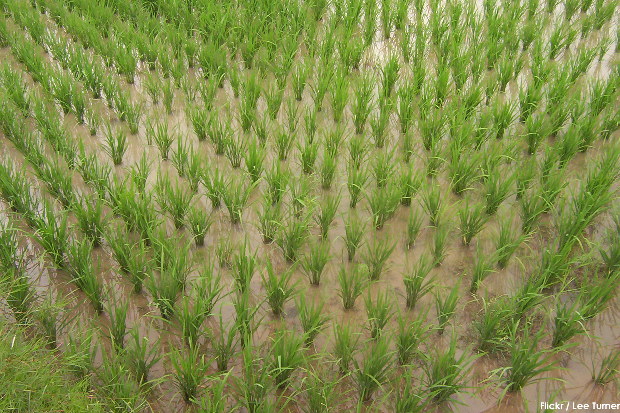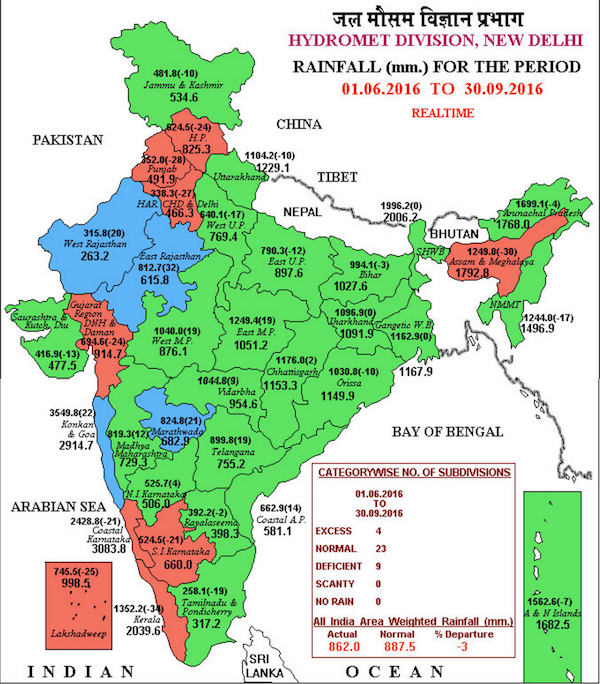Monsoon Ends This Week, Record Food Output Likely
A "normal" monsoon and adequate water in major reservoirs nationwide, coupled with more money to agriculture, have set the stage for a record agricultural output of 270 million tonnes—2% in excess of the government's target—for the kharif (summer) and rabi (winter) crops of 2016.
With the southwest monsoon officially withdrawing this week, water available in 91 reservoirs nationwide is 25% more than the amount available in October 2015, according to Central Water Commission data, except in Karnataka and Gujarat, which face more than 20% deficit in seasonal rainfall.
Against the government target of 132 million tonnes, India is set for a kharif output of 135 million tonnes, according to preliminary government estimates; the previous highest was 131 million tonnes in 2011-12.
It also appears India will meet the rabi target of 137 million tonnes, one million tonnes more than the previous high in 2013-14.
A third of India’s districts were faced with deficient rainfall in the June-August period, as IndiaSpend reported in August 2016; it now appears that Karnataka and Gujarat will be hardest hit, according to this October 2016 report Monsoon Granular Review by CRISIL, a research agency.
A "double whammy"—three-year successive years of deficient rainfall and poor irrigation facilities—makes 13 districts in the two states the worst affected in this "normal" monsoon season, the report said.
Agriculture reviving, but households may suffer
The four-month monsoon season ended within normal limits of (+/-) 4% of the 100-year average. The actual deficit was 3%—India received 97% of normal rainfall in the June-September period—diverging from the prediction of 6% excess rainfall forecast by the India Meteorological Department (IMD) as the monsoon began.
The 91 major reservoirs monitored by the Central Water Commission are at 75% capacity, equaling the average availability of last 10 years.
“The share of distressed districts in all-India kharif production is just 1.7% but the stress to agricultural household incomes could be high because a quarter of the kharif production in Karnataka and a third in Gujarat comes from the distressed districts,” the CRISIL report said.
Even with Uttar Pradesh, Punjab, Haryana and Kerala getting less-than-normal rains, adequate irrigation facilities will ensure that these states are not affected as much as Karnataka and Gujarat, the report said.
With the exception of some districts in some states, the picture for India’s agricultural economy looks positive due to the fact that the sowing of the summer crop has crossed the end-of-September average sowing of 102.5 million hectare to reach 107.1 million hectare.
Source: 4th advanced estimates of agricultural production, ministry of agriculture, figures in million tonnes
Note: For 2015-16: 4th advanced estimates; for 2016 kharif: 1st advance estimate; for 2016 rabi production: set target; rest of the years: actual production.
Pulses output in the kharif season was estimated to be 8.7 million tonnes, 22% more than the best of 7.1 million tonnes achieved in 2010-11, and 60% more than last year's 5.5 million tonnes last year.
Oilseeds production is set to be 234 million tonnes, 4% more than the best of 226 million tonnes produced in 2013-14.
Source: All India Crop Situation as on September 30, 2016, Ministry of Agriculture
Bordering regions have deficit, central India in excess
Every monsoon—whether it good (above normal) or bad (below normal)—leaves some areas inundated and some parched. In the "normal" monsoon of 2016, eight states received less than 85% of normal rains.
A normal monsoon in 2013 hid 30% and 23% deficits in Bihar and Jharkhand respectively.
In 2016, except for central India, the other three regions—northwest, southern peninsular and eastern (including northeast)—reported deficits in June-to-September rainfall.
Only four of 36 meteorological sub-divisions received more than 20% above normal rainfall. Drought-stricken Marathwada and the coastal strip of Konkan in Maharashtra received 22% and 21% above-normal rainfall, while two divisions of Rajasthan, west and east, received 20% and 32% above-normal rains, respectively.
Nine divisions—covering eight states—of coastal and southern Karnataka, Kerala, eastern Gujarat, Punjab, Haryana, Himachal Pradesh, Assam and Meghalaya have received less than 80% of the normal monsoon rain.
Twenty-three divisions—covering the whole of eastern and central India—received normal rainfall.
Cash crops hit, eastern states to benefit
The north-eastern monsoon—or the retreating monsoon, as it is called—is set to give normal rains to Tamil Nadu, southern Karnataka, Andhra Pradesh and Orissa, according to the IMD forecast, offering relief to the distressed parts of the states.
Cotton and sugarcane, the major cash crops of India, have suffered in this season. Cotton has been planted on 83% of normal cropped area, and its production is expected to be 11% less than the best production of 360 lakh bales achieved in 2013-14.
Sugarcane is being cropped on 90% of normal cropped area, and the season is expected to produce only 82% of the best cane production of 360 million tonnes achieved till date (2011-12 and 2013-14).
---
(Waghmare is an analyst with IndiaSpend.)
We welcome feedback. Please write to respond@indiaspend.org. We reserve the right to edit responses for language and grammar.
__________________________________________________________________
“Liked this story? Indiaspend.org is a non-profit, and we depend on readers like you to drive our public-interest journalism efforts. Donate Rs 500; Rs 1,000, Rs 2,000.”




